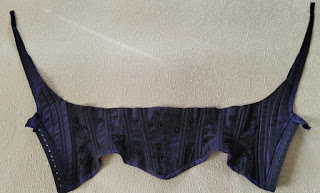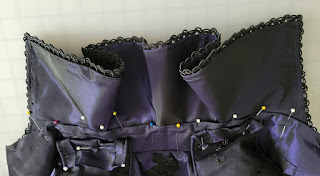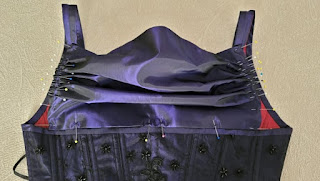Previously in A Wicked Witch - The Plan:
The Blog Post:
http://theperfecttouchvictorian.blogspot.com/2021/01/foundations-revealed-is-online.html
The blog post linked above will give you the project beginnings and preparation for recreating the Supreme Witch illustrated by the talented DeviantArt artist Sedeptra. With her permission I have begun a project that is inspiring, exciting, and will stretch me far beyond my current skills.
This post is Part 2, and the video which I will link below, will detail the creation of the gown. Both are lengthy and I recommend you conjure up your favorite magic potion and curl up and enjoy. To be able to cover all the steps in the creation of the hat and broom, as well as the final wearing and reveal, I will publish a separate post and video for those in a Part 3.
Do you have your magic potion? Good! So do I! Let's begin our journey!
The gown I have planned consists of an underskirt, draped overskirt, corset, and sleeved shrug with standing collar.
The Underskirt: As with any project, it can be rewarding to begin with something familiar and I do that with the slim underskirt using a pattern I've sewn from before, TV225 1878 Fantail Skirt by Truly Victorian.
The bedroom floor is a great place to cut the long pattern pieces.
The back panels are gathered onto the waistband and the hem is hand sewn and the overskirt is finished! Although not shown on the illustration, the fantail is a nice added back detail and also makes the underskirt reusable for future Victorian costumes.

As I studied Sedeptra's illustration of the overskirt I realized the hip width would likely not be accomplished with the draped fabric alone. I printed the illustration and using my own height as a guide, I calculated the life-size dimensions of all parts of the illustration.
Locating hip pads online and purchasing on Amazon was surprisingly simple and inexpensive. The pads are smooth on the interior and nicely shaped on the exterior to follow the curve of the hip, extend down the thigh, and curve around to the backside.
The hip pads increase the hip measurement over the petticoat and underskirt from 41-1/2" to 48-1/2". A very nice curve!
The overskirt appears to be pleated and overlapped and then draped over each hip dipping low on each side.
I pleat one edge of the fabric in 40 1/2" pleats which will take up 60", drape the fabric to mimic the length of the drape and pull it up to the center back. I decide to double that length and repeat the pleating and draping for the other side.
Everything is then carefully removed from the dressform, a waistband added which is the same width as the waistband of the underskirt, and the bustle tapes moved to the interior. Everything is sewn and secured.

I transferred the pattern to coutil adding seam allowances as indicated in the directions. My corset will have 17 panels with the front panel a single piece to follow the artist's illustration.
I narrowed down the options to a black applique or a black beaded and embroidered net overlay. Since I will have some black touches in the overall design I think either of the black options are beautiful. To help with the decision I put the options out for a vote to both Facebook friends and Instagram followers.
Which did you choose? The overwhelming choice was the beaded and embroidered net overlay and I decide that some touches of the applique might be perfect as well.

With all decisions made and the coutil cut, the faux taffeta, the net overlay, and a burgundy lining layer are all cut. The bust pieces will be faux taffeta with the burgundy lining, and the underbust support has an additional layer of coutil. Now to keep everything organized!
The center piece will not have a busk and instead I create a channel and will use a piece of reed for support.

When the next panel is to be sewn I lay the previous panel over a sewing ham to allow the fabric to naturally curve and be pinned as it will naturally curve over the body.

The back panels are sewn as are the bust supports and bust sections.
I sew the bias binding to the lower edge of the corset and outside edges of the back first by machine and then turn the bias binding to the inside and sew by hand.
What do they say about the best laid plans? No matter how careful I try to be there seems to be something I miss and in this case it was with the boning. I was prepared to cut my own steel boning until I read the instructions again and realized I needed spiral boning. Spiral! And I can understand that as I have so many bones and some drastic curves in this corset. Luckily I place my order and the bones arrive within days!
The shape of the corset is beautiful with the boning added.
The bust cups can now be sewn to the corset front.
Shrug and Gathered Bodice:
Recreating this part of the illustration was the most difficult for me as it meant drafting so many pieces for which I had no experience. So I started with something familiar, the Truly Victorian pattern TV420 1879 Cuirass Bodice. I chose this pattern for the standing collar, the sleeves, and basic bodice body.
I drafted the front opening shape and transferred my pattern to the fabric.
I drafted a large collar using the dimensions of the standing collar from the bodice pattern. I also drafted the shoulder embellishment pieces using the shoulder pads as a starting point and cut fabric and the same beaded overlay used on the corset. I cut strips of the silk organza for the upper arm detail, sewed the sleeve pieces together, and now all pieces are ready for final assembly. I'm amazed at how many pieces it takes to create this 'simple' shrug!
To double check that I have everything I think I need I pin the pieces onto the dressform and check that the silhouette looks right. I do love the touches of black against the purple/black shot faux taffeta! I sew the narrow standing collar and sleeves to the bodice, and sew in the lining.
I decide to complete the large collar next. I baste the undercollar to the buckram and then sew the upper collar right sides together, notch, turn and press.
To add stability and shaping ability I sew channels at the corners where the curve meets the straight side, and at both front edges. I insert #19 millinery wire in the channels leaving the wire long enough so that I can cut it to the correct length when attaching to the standing collar.
The next challenge...the shoulder embellishment...
I baste the beaded net overlay to the shoulder pieces and then sew piping down both long edges of each piece and then along the curved edge leaving enough piping on each side to attach the gathered upper sleeve.
Now I have two shoulder embellishments with upper sleeve gathers ready to attach to the bodice.
The pads are stitched to the shoulder pieces and the shoulder pieces are hand stitched to the bodice at the piping inner seam. And I hand stitch an applique over the center back seam. The upper edge of the standing collar has been machine stitched 1/2" away from the top edge creating a channel to insert the large collar. I test that fit of the collar and take photos to determine if I am satisfied with the silhouette and recreation.
The front lower edges of the shrug did not extend as far as I liked so I added an extension which gives some added dimension to the shrug. But I quickly realize that although I extended the shoulders to balance the width of the hips, I'm not satisfied with how far they extend.
As I look at the back of the shrug I'm happy with the length but decide it needs some weight. I think more piping will be perfect. And even relative to the widened hips, the shoulders seem too wide. I remove and reattach the shoulder embellishments creating a narrower shoulder width and it feels much more balanced to me.
And add piping. Then I hem and trim the gathered upper sleeves.
Although they will be covered by gloves when worn, I add the similar trim to the lower sleeve edges.
With the collar and shoulders and additional piping added I stand back and feel the back is lacking something. The illustration only shows the front of the gown so this is my chance to add my personal touch. I add more applique with more beading and some dimension in my placement and stitching.
The fabric is pleated, pinned to the corset bust sides and lower edge, and hand stitched.
The center gathering strip is created with the fabric and the net overlay.
The gather strip is threaded through an opening left at the lower edge and the ends sewn together inside the gathered bodice. The pleats are adjusted and I love the effect of this bodice!

The shrug fits over the gathered bodice beautifully and now I can finish the shrug front. There are some details I can see in the illustration and some that are not as clear to me. I have some black glass buttons left from a Victorian gown made years ago and they blend nicely with the crystals on the triangle. I sew 4 to the shrug.
I decide I like the edges without the trim and finish stitching the trim on the standing collar, add the embellished triangle, and complete the closure with snaps.
I can hardly believe it!! The shrug is complete! Actually the entire gown and project are complete except for photos and video! Here are a few of the completed shrug and I'll include a few of the completed gown but the full wearing will be in Part 3.
Finished Gown:
Hugs,
Jeanette
.jpg)



































































































































































This comment has been removed by a blog administrator.
ReplyDeleteThis comment has been removed by a blog administrator.
ReplyDelete